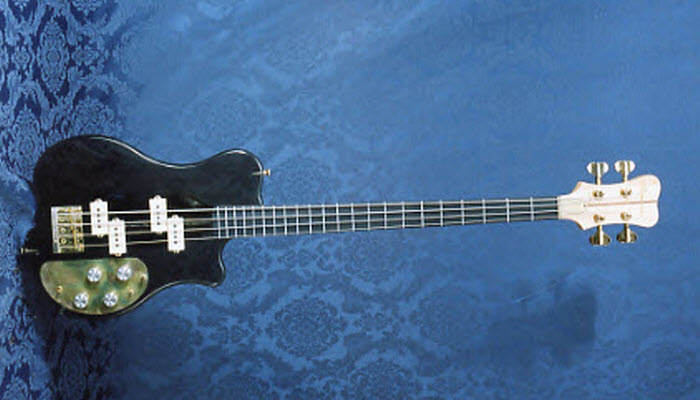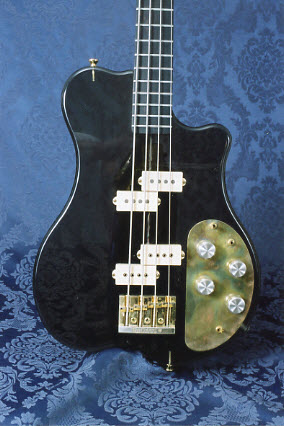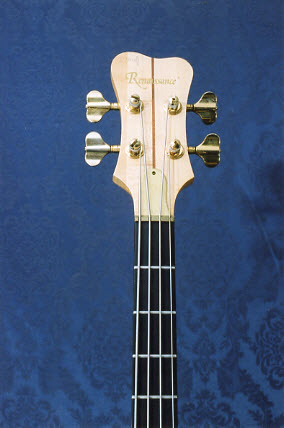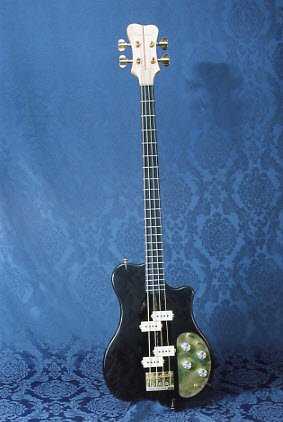
Knowledge can be a terrible thing, especially if you’re a collector like me. Once I learn about a subject—say, an obscure guitar maker with connections to bigger things that almost no one knows about—I want one, or two. Never fails. That’s how I ended up with this 1981 Renaissance bass.
Now, basses have rarely spoken to me. I was always a 6-string man. Although, that said, I actually did play bass (and sing) briefly in a band for a few months back in 1967 (a rent-to-own, baby blue Hagstrom, as I recall). Most of the time, in a shop or at a show, I usually walked right past the bass guitars.
In any case, the road to my Renaissance began in the shop window of Society Hill Loan on South Street in Philadelphia. I used to work in an office tower near City Hall. I was a writer and no one paid attention to us, so I found that on my lunch break I could zip out, hop on a bus, and in a few minutes find myself walking down 7th Street toward Temptation. South Street was home to a lot of clubs and young hipsters, so naturally Society Hill got lots of interesting instruments.
One day I walked up to the corner display and staring back at me was a clear Plexiglas bass guitar bearing the Renaissance brand. This was one of those RARE instances where the guys in the shop actually knew something about Renaissance. They knew they came from the western suburbs of Philly, maybe Newtown Square, and a music store called Dragonetti’s. This was way more information than the usual shrug and “I dunno” that I usually got. A red hot lead!
I didn’t buy the bass that day. In fact, in a rare occurrence, I didn’t even own any Renaissance gear when I tracked the company down. Which wasn’t all that hard. I just let my fingers do a little walking—this was way before you “Googled” anything—and found Dragonetti’s Music located in Newtown Square, PA, in Ma Bell’s Yellow Pages. A quick call and I reached store owner John Dragonetti. “You know anything about Renaissance guitars,” I asked. “Do I? You can’t imagine how much that cost me.” Pay dirt!
Turns out Dragonetti marked the end of the Renaissance saga, not the beginning. The story began in around 1977 when a young John Marshall decided to go into guitar making instead of college. Marshall had learned how to build guitars from Eric Schulte, a well-known local luthier living in Malvern, PA, a far northwestern suburb of Philly a few miles north of Newtown Square. Marshall got together two partners, recording studio owner Phil Goldberg and studio guitarist and manufacturer’s rep Dan Lamb and founded Renaissance guitars in Malvern.
In search of something different, the trio settled on using Plexiglas, inspired by the old Ampeg Dan Armstrong guitars of a few years earlier. Marshall came up with the design. Both the guitar and the bass were similar to what you see here. Three shades of Plexi were offered: clear, smokey gray, and black. Prototypes were made in late 1977 and production began in 1978.
This bass is the SPB Gold model built in May of 1979, in the smokey grey known as “Bronze.” The neck is 3-piece mahogany. What you can’t see are brass dot position markers along the side of the ebony fingerboard. It has active electronics with two notched filter tone controls, and active/passive switch, phase switch, and a pair of special designed DiMarzio pickups. I’m not really qualified to evaluate basses based on my brief Hagstrom experience, but I think this is pretty top-notch!
However, sales did not go well for Renaissance and the instruments were expensive to make. They needed an infusion of cash. That’s when John Dragonetti was brought in. John Marshall had become disgruntled and left to take a job with Martin. Dragonetti put in some capital and immediately found his new partners absent and in early 1980 pretty much in sole control. He redesigned the instruments in an attempt to make them less expensive to produce, the new shapes reflecting more of a B.C. Rich influence. Sunn amplifiers were interested in purchasing Renaissance, but a fluke accident at the NAMM show scuttled that deal. That’s when the IRS knocked on the door… The end.
Renaissance guitars and basses are relatively rare. Generously speaking there were only about 600 give or take of six various designs. Basses in this design were around 150 in number, divided between two different models, so maybe 75-100 of these were made, at most.
Being Plexiglas, this is relatively heavy. In my dotage, I like light-weight. However, the likelihood that I’ll join a band and play any bass is remote indeed. Also, I tend to stay away from pawn shops, as well. You never know what you’ll learn about, and you know where that can lead…




I have one of these basses. Your post here is very informative and interesting. I’m trying to find out what this thing is worth. I bought it many years ago but as you stated, it is very heavy. I think I have used it on stage twice in the last 15 years. Do you know where I might get an honest appraisal?
Jay
I am always buying Renaissance guitars, basses, etc… Email me at the shop or call 717-361-9272.
Thanks,
Jim
As always a fascinating article on a lesser-known company. Have you ever heard of, or written about, the Bolt Electric Guitar Company that was located near Philly 20 or so years ago? I picked up one of their guitars off ebay recently and I was impressed, but there’s not too much info on them out there.
Thanks,
Rich
That’s a three piece maple neck, isn’t it?
This made me laugh because I saw Marah (THE Philly band) play a gig in 98/99 and they all were playing these guitars and basses… and I actually saw these in stores back in the 80’s around the area… I always assumed they were sombody’s idea of a Dan Armstrong copy, but they are obviously very much their own creation. Very interesting!
The Marah Show mentioned above can be seen on you tube, just punch in heading Marah live 10.31.98
I have a Renaissance t-200g bought new, gigged for a couple years, been in a closet ever since! Your article from way back when is the only info I have seen! It seems that the time has come for someone else to take care of this rare piece! I don’t know where to start! Any insight you can share would be a major help! Thanks for your time!
Joe M
Back in 1992, I have a clear renaissance bass that I bought at a pawn shop for $150.00. I just thought it was cool looking, I didn’t know anything about basses. That thing weighed a ton, but had the active boost, which was cool. I used it to play bass for the church I was attending maybe 10 times. Then, after a Saturday night service i left it on stage because i was going to play Sunday service too. Came sunday morning and it was gone. Someone stole from the church stage. I always wondered if it was worth anything? Casey
Thanks for the post. I echo the sentiments that it’s informative and interesting. I have a Renaissance guitar that I first bought in 1980 or ’81. It was my second electric guitar, that I got with money I saved at a part time job as a sophomore or junior in high school.
I am at one time owned the second renaissance bass John ever made. The sustainand sound Were amazing at that time I didn’t regret trading in my Gibson EBO base for the Renaissance. I was playing in a rock band so it looked cool also. The downside, the base was superheavy and your shoulder was just about to come off by the end of the third su were amazing at the time I didn’t regret trading in my Gibson EB oh bass for the Renaissance. I was playing in a rock band so about cool also. The downside, the base was superheavy and your shoulder just about to come off by the end of the third set. Also the base was waited terribly where even though the plexiglass was superheavy the headstock was even heavier so you spent the night lifting the headstock as you played as so it would not get to the dip to the floor. By the time I was cutting albums at Sigma sound in Philadelphia in 1982 the intonation in the Bass had become Unmanageable. Because of the five different kinds of wood John used in the neck would not align with the plexiglass in the body of the guitar unfortunately it became nothing but a wall hanger. I ended up trading in the base getting some cash and at the time I picked up a Ibanez road star. I was doing a session one night as sigma and the engineer asked me what kind of faces on manageable. Because of the five different kinds of wood John used in the neck would not align with the Plexiglas in the body of the guitar unfortunately it became nothing but a wall hanger. I ended up trading in the base getting some cash and at the time picked up a Ibanez road star. I was doing a session one night as Sigma and the engineer asked me what kind of bass is that? I thought here we go there’s a buzz somewhere. I told him what kind of base it was and he said that thing sounds great I think I’ll get one for the studio. So I scaled down my expensive renaissance to a fender PBase copy and it served me well. My only regret is turning in my early 70s EBO for the Renaissance. In John’s defense he was a really good guitar repair man just not a fan of the renaissance bass guitar. He even had a fretless six string electric plexiglass guitar. I have no idea how many of those he made but they were strange
I bought a Renaissance 4 string bass Smoky plexiglass brand new in 1979. Still have it. Still plays excellent and in excellent condition yes it does weigh Aton but the tone and playability make up for it. I never had any issues with it other than a neck adjustment a few years back
Does anyone have a circuit diagram for the R/ Bass? (Mine is not working right now because I tried to replace a mini switch and messed up the job).
I have had mine since 78 or 79. the sound is great and sustains forever.
I don’t understand why the intonation would “go bad”. Everything is adjustable on the Bass, the neck and the bridge can easily be adjusted unless you had a neck which has twisted…mine is primo after 40 years. Absolutely a heavy instrument. I use a 4 inch wide strap. I think that it would be a perfect Studio Bass due to excellent tonal spectrum thanks to active/passive wiring. You would probably want to sit down while playing it to relieve your shoulder.I can see why you wouldn’t want to play three sets with it hanging on your neck.
I bought a 1979 Renaissance’ Bass brand new. I played on a lot of Boston stages with that bass. I still have it and will turn it back to original shape. Hope I’ll have pics soon?